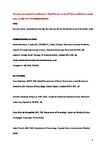Sensory–motor rehabilitation therapy for task-specific focal hand dystonia: A feasibility study
| dc.contributor.author | Butler, K | |
| dc.contributor.author | Sadnicka, A | |
| dc.contributor.author | Freeman, Jennifer | |
| dc.contributor.author | Meppelink, AM | |
| dc.contributor.author | Pareés, I | |
| dc.contributor.author | Marsden, Jonathan | |
| dc.contributor.author | Edwards, MJ | |
| dc.date.accessioned | 2018-04-27T10:35:20Z | |
| dc.date.available | 2018-04-27T10:35:20Z | |
| dc.date.issued | 2018-06-01 | |
| dc.identifier.issn | 1758-9983 | |
| dc.identifier.issn | 1758-9991 | |
| dc.identifier.uri | http://hdl.handle.net/10026.1/11367 | |
| dc.description.abstract |
© 2018, The Author(s) 2018. Introduction: Medical treatments have limited long-term effect in task-specific dystonia. Whilst evidence supports the use of rehabilitation, no randomised controlled trials have been undertaken. This small-scale study determined the feasibility of implementing and evaluating a mixed sensory–motor task-specific dystonia rehabilitative programme. Methods: Participants with writer’s or musician’s dystonia were recruited from a movement disorder and hand therapy clinic. Feasibility measures were recruitment rate, retention, session attendance, adherence to exercises. Self-report measures at 0, 3 and 6 months included: Arm Dystonia Disability Scale (ADDS), Tubiana and Chamagne Scale (TCS), Brief Illness Perception Questionnaire (BIPQ), Health Status (EQ-5D 5L), Clinical Global Impression Scale (CGI). Task performance was video-recorded at baseline and 6 months. At 6 months, interviews explored participant experiences of the intervention. Results: Fifteen patients were recruited over 6 months (rate 2.5/month, musician’s dystonia = 8, writer’s dystonia = 7). Complete data sets were collected for twelve people(80%). The programme comprised a maximum six sessions plus daily home exercises. Nine completed the home programme at ≥75%. No adverse events were reported. Effect sizes at 3 and 6 months, respectively, were ADDS 3-month = 0.28, 6-month = 0.23; TCS 3-month = 0.13, 6-month = 0.53; BIPQ 3-month = 0.38, 6-month = 0.71; EQ-5D-5L 3-month = 0.34, 6-month = 0.59; video analysis at 6 months = 0.78. Eleven (92%) improved on the CGI. Interviews supported acceptability of the intervention. Conclusions: This intervention was feasible to deliver with high retention, adherence and acceptability. Improvements occurred across measures. This informs the development of future randomised controlled trials. | |
| dc.format.extent | 53-63 | |
| dc.language | en | |
| dc.language.iso | en | |
| dc.publisher | SAGE Publications | |
| dc.subject | Rare Diseases | |
| dc.subject | Clinical Research | |
| dc.subject | Behavioral and Social Science | |
| dc.subject | Neurodegenerative | |
| dc.subject | Clinical Trials and Supportive Activities | |
| dc.subject | Dystonia | |
| dc.subject | Neurosciences | |
| dc.subject | Rehabilitation | |
| dc.subject | Physical Rehabilitation | |
| dc.subject | 7.1 Individual care needs | |
| dc.subject | 6.6 Psychological and behavioural | |
| dc.title | Sensory–motor rehabilitation therapy for task-specific focal hand dystonia: A feasibility study | |
| dc.type | journal-article | |
| dc.type | Journal Article | |
| plymouth.issue | 2 | |
| plymouth.volume | 23 | |
| plymouth.publication-status | Published | |
| plymouth.journal | Hand Therapy | |
| dc.identifier.doi | 10.1177/1758998318764219 | |
| plymouth.organisational-group | /Plymouth | |
| plymouth.organisational-group | /Plymouth/Faculty of Health | |
| plymouth.organisational-group | /Plymouth/Faculty of Health/School of Health Professions | |
| plymouth.organisational-group | /Plymouth/REF 2021 Researchers by UoA | |
| plymouth.organisational-group | /Plymouth/REF 2021 Researchers by UoA/UoA03 Allied Health Professions, Dentistry, Nursing and Pharmacy | |
| plymouth.organisational-group | /Plymouth/Research Groups | |
| plymouth.organisational-group | /Plymouth/Research Groups/FoH - Applied Parkinson's Research | |
| plymouth.organisational-group | /Plymouth/Research Groups/Institute of Health and Community | |
| plymouth.organisational-group | /Plymouth/Research Groups/Plymouth Institute of Health and Care Research (PIHR) | |
| plymouth.organisational-group | /Plymouth/Users by role | |
| plymouth.organisational-group | /Plymouth/Users by role/Academics | |
| plymouth.organisational-group | /Plymouth/Users by role/Researchers in ResearchFish submission | |
| dcterms.dateAccepted | 2018-02-12 | |
| dc.identifier.eissn | 1758-9991 | |
| dc.rights.embargoperiod | Not known | |
| rioxxterms.versionofrecord | 10.1177/1758998318764219 | |
| rioxxterms.licenseref.uri | http://www.rioxx.net/licenses/all-rights-reserved | |
| rioxxterms.licenseref.startdate | 2018-06-01 | |
| rioxxterms.type | Journal Article/Review |


